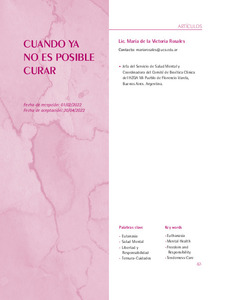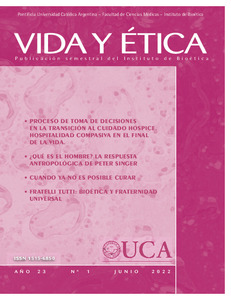Por favor, use este identificador para citar o enlazar este ítem:
https://repositorio.uca.edu.ar/handle/123456789/16444| Título: | Cuando ya no es posible curar | Autor: | Rosales, María de la Victoria | Palabras clave: | ENFERMOS TERMINALES; EUTANASIA; SALUD MENTAL; BIOETICA CLINICA; MUERTE | Fecha de publicación: | 2022 | Editorial: | Educa | Cita: | Rosales, M. de la V. Cuando ya no es posible curar [en línea]. Vida y Etica. 2022, 23 (1). Disponible en: https://repositorio.uca.edu.ar/handle/123456789/16444 | Resumen: | Resumen:
Se trazan tres coordenadas: Concepto de
riesgo para sí mismo, Libertad y Responsabilidad y Ternura; a partir de las cuales
comenzar a pensar acerca de la intervención del profesional de Salud Mental
en la atención del enfermo en situación
terminal, que pide la eutanasia.
El psicólogo interviene con recursos terapéuticos excepcionales (internacion
involuntaria) cuando ha dictaminado
previa evaluación , que el paciente presenta riesgo cierto e inminente para sí
o para terceros. La ley de Salud Mental subraya la importancia de buscar
todas las alternativas eficaces para
el tratamiento del enfermo, señala la
importancia de fundar en un examen
interdisciplinario la declaración de
inhabilitación e incapacidad de una
persona, especificando funciones y actos que se limitan y cuidando siempre
la no afectación de la autonomía del
paciente. Frente a la opción de la eutanasia, es tarea del profesional de la
Salud Mental detectar que no siempre el paciente podrá tener la lucidez
y el valor para manifestar un auténtico
sentir en relación a su muerte. Requiere
una especial consideración la etapa de
la enfermedad o el estado del paciente,
que hacen diferencias en la valoración
de su capacidad para tomar decisones
con plena autonomía, asumiendo que
es ésta una de las escenas posibles donde se encuentra en riesgo para sí. Es
tarea del psicólogo, intervenir en un marco interdisciplinario, revisando y
evaluando las condiciones psíquicas y
emocionales del paciente cuando pide
su muerte: es eso lo que literalmente solicita?, es necesario interrogarse:
está en condiciones de decidir plena y
cabalmente? Es precisamente porque
esa habilidad expresiva se encuentra
disminuida en el enfermo grave, que
se vuelve indispensable decodificar las
formas de comunicación y explorar la
existencia de vínculos afectivos, buscar la participación de la familia y del
equipo médico tratante y extender la
responsabilidad de una decisión que
el enfermo, por falta de capacidad de
dominio sobre sus propios impulsos, no
puede tomar por sí mismo y en soledad.
Cuidar cuando ya no es posible curar,
hacerce cargo del otro en su vulnerabilidad extrema, custodiar y cuidar la
vida y promover verdaderas decisiones
libres, se proponen como herramientas
terapéuticas en el cruel escenario de la
eutanasia. Abstract: Three coordinates are drawn: Concept of risk to oneself, Freedom and Responsibility and Tenderness; From which to begin to think about the intervention of the Mental Health professional in the care of the patient who requests euthanasia. The psychologist intervenes with exceptional therapeutic resources (involuntary hospitalization) when he has ruled after an evaluation that the patient presents a certain and imminent risk to himself or to third parties. The Mental Health law underlines the importance of looking for all effective alternatives for the treatment of the patient, points out the importance of founding in an interdisciplinary examination the declaration of disqualification and incapacity of a person, specifying functions and acts that are limited and always taking care not affecting the autonomy of the patient. Faced with the option of euthanasia, it is the task of the Mental Health professional to detect that the patient may not always have the lucidity and courage to express an authentic feeling in relation to her death. The stage of the disease or the patient’s condition requires special consideration, which make differences in the assessment of their ability to make decisions with full autonomy, assuming that this is one of the possible scenes where they are at risk for themselves. It is the task of the psychologist to intervene in an interdisciplinary framework, reviewing and evaluating the psychic and emotional conditions of the patient when he asks for his death: is that what he is literally asking for? it is necessary to ask oneself: is he in a position to decide fully and completely? It is precisely because this expressive ability is diminished in the seriously ill, that it becomes essential to decode the forms of communication and explore the existence of affective ties, seek the participation of the family and the treating medical team and extend the responsibility of a decision that the patient, for lack of ability to control his own impulses, cannot take by himself and alone. Caring when it is no longer possible to cure, taking charge of the other in their extreme vulnerability, guarding and caring for life and promoting true free decisions, are proposed as therapeutic tools in the cruel scenario of euthanasia. |
URI: | https://repositorio.uca.edu.ar/handle/123456789/16444 | ISSN: | 1515-6850 (impreso) 2683-6998 (online) |
Disciplina: | BIOETICA | Derechos: | Acceso abierto | Fuente: | Vida y Etica Año 23, No.1, 2022 |
| Aparece en las colecciones: | VE - 2022 Año 23 nro. 1 |
Ficheros en este ítem:
| Fichero | Descripción | Tamaño | Formato | |
|---|---|---|---|---|
| cuando-ya-no-posible-curar.pdf | 97,95 kB | Adobe PDF |  Visualizar/Abrir | |
| vidayetica2022-1-portada.pdf | 1,35 MB | Adobe PDF |  Visualizar/Abrir |
Visualizaciones de página(s)
52
comprobado en 27-abr-2024
Descarga(s)
63
comprobado en 27-abr-2024
Google ScholarTM
Ver en Google Scholar
Este ítem está sujeto a una Licencia Creative Commons

